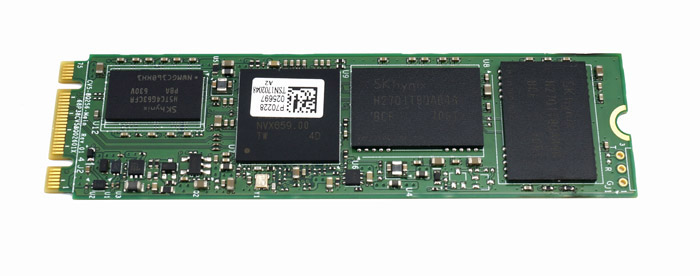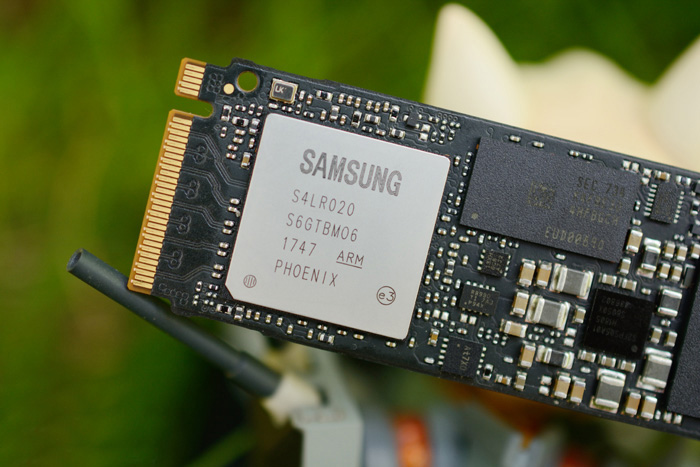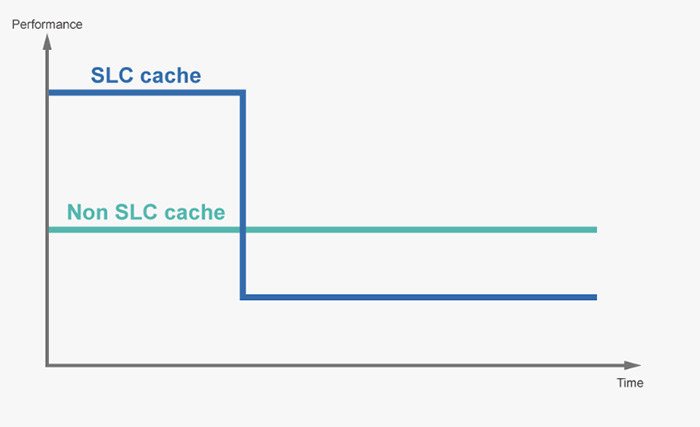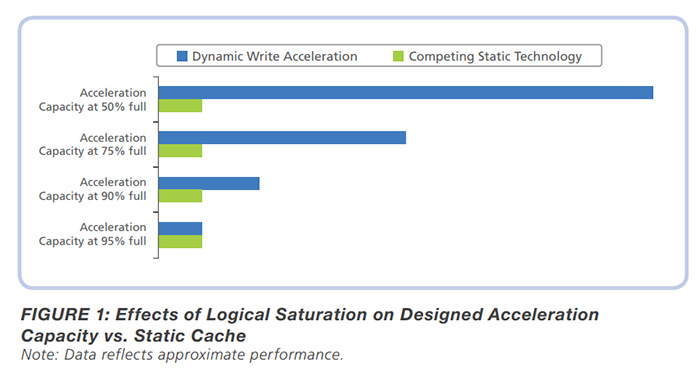Why does speed drop happen in TLC/QLC SSD?(end)

Master control of solid state drive is essentially based on ARM or self-developed CPU. In order to improve performance, master control is often adopted multi-core architecture. Master control with three-core or even four-core master control is not rare. Fever under high load is a common problem. For PCle or M2 solid state drive with high performance, the small space leads to heating concentration. It is unusual for the temperature of master control to exceed 90 °C and even 100 °C. In order to avoid high temperature damage, solid state drive will utilize a temperature control mechanism. If its temperature is too high, the frequency will be lowered and heat will be reduced further.
However, reducing the master control frequency will actually reduce SSD performance. In order to solve the problem of overheating, the most commonly used means is to improve the heat dissipation effect. For example, Samsung used better packaging in the master control design of 970 Pro hard disk. The whole master control used metal encapsulation to improve the thermal conductivity.

Of course, the more direct way is to install heat sinks. You can see that all kinds of M.2 solid state drives have begun to popular heat dissipation vest. Previously, Galaxy also launched a kind of M.2 solid state drive with a surprising thickness of heat sinks. Although its appearance is bit ugly, the effect is very good.
In addition to the reasons mentioned above, there are actually some other factors that will affect the normal performance of solid state drive, such as 4K alignment, synchronous/asynchronous flash, AHCI/IDE mode and so on. But these operations are not the master problem now. In the past, the major problem is that because SSD was not popular, many people did not understand the settings. Nowadays, Windows system itself has added a lot of SSD optimization settings, and third-party tools for SSD support is also in place.
Cache structure of solid state drive: from DRAM Cache to SLC Cache
The above content involves all aspects for solid state drive performance reduction. In actual, for a single solid state drive, performance reduction is not so complicated. Here is what we are going to get to the point. First of all, let us look at the basic structure of modern solid state drive.

Whether it is SATA or M.2 solid state drive, their PCB layout is similar. From left to right, the structure of M.2 solid state drive above is DRAM cache, master control and NAND flash memory. Among them, the master control and NAND flash memory are essential, while DRAM cache is not necessary. The low-end solid state drive without DRAM cache is to reduce costs. Especially when the price of DRAM memory became higher and higher in the past two years, low-end solid state drive was more popular with DRAM-free caching schemes, but it would use HMB host memory caching to compensate for performance reduction.
On the contrary, DRAM cache is indispensable for high-performance solid state drive. Even if it is DDR3 cache, its bandwidth can reach several GB/s or even more than 10 GB/s, which is far higher than the performance of solid state drive flash. DRAM cache is very helpful to improve performance. Now Samsung and other companies have begun to use DDR4-2133 as cache on high-end solid state drive.
As for DRAM cache capacity, there is commonly 128MB, 256MB and 512MB. With the increasing capacity of solid state drive, 1GB DRAM cache is not rare. Generally speaking, it is better for 1TB flash memory equipped with 1GB DRAM cache. In short, the higher cache is, the better performance.
DRAM cache is the first cache structure in modern solid state drive. When reading data from solid state drive, first see whether there is any data needed in the DRAM cache or not. If there is some data in the DRAM cache, use it first. At this time, the speed will be very fast. If not, search for data in NAND flash. But the speed is much slower.
Generally speaking, DRAM cache is to increasing the performance of solid state drive. There is still a speed drop from DRAM cache to NAND flash memory, although this kind of speed regulation cannot be felt by everyone. After all, the cache capacity is too small and easy to exceed.
The performance of solid state drive mostly depends on NAND flash memory. But we all know that write performance is declining from SLC to MLC, TLC and now just emerging QLC flash memory. The original TLC and QLC flash is very terrible in performance. Without any modification, write performance of QLC flash may not be 100 MB/s. Even hard disk drive is faster than QLC solid state drive.

However, for actual TLC and QLC solid state drive sold, regardless of SATA or M.2 interface, its performance is very great. Samsung claims 970 EVO products such as 250GB version can reach 1500MB/s in write performance. It is the apparent performance after using write acceleration technology. In fact, its actual performance is about 300 MB/s, less than four times the apparent performance.
SSD write acceleration technology is a general term, and its common solution is SLC cache. Its literal meaning is that SLC is served as a cache to accelerate, because SLC flash has the best performance.

In the era of MLC flash memory, SLC caching technology is not necessary. Samsung 970 Pro does not use such technology, while 970 EVO does use. However, there is something to sacrifice when using SLC cache. SLC can only store one bit of data and TLC is three bits of data, together with QLC storing four bits of data. Using SLC cache in TLC/QLC flash memory means sacrificing capacity for performance, which is not a better choice.
It seems so cool to use SLC cache to improve the writing speed of solid state drive, but it means losing a portion of the space. How much losses depend on the solution manufacturers choose. If the overall solution is adopted, it means only one third or even one fourth of the capacity is available.

Using SLC cache is like a roller coaster
More importantly, even with SLC cache, once the written data exceeds cache capacity, solid state drive performance will still be the same as before and its speed will become slower and slower. The original TLC/QLC performance will have to be used after the cache acceleration space is exceeded. At this time, the write speed of about 100MB/s is normal.
Of course, the additional benefit of SLC cache is also exiting, for example, the loss is smaller when the power is unexpectedly off. After all, SLC only stores one bit of data.
Different SSD manufacturers have different names for SLC Cache technology. It is called TurboWrite by Samsung, as well as nCache in SanDisk and Dynamic Write Acceleration in Micron. In fact, these technologies are also divided into different types, including full SLC cache and partial cache. Among them, the full cache is the best, but wastes a lot space. So now SLC Cache technology generally delimits a part of the space. How much space left depends on the manufacturer’s comprehensive consideration, usually 10% below or 20%.

In addition, regardless of full or partial space simulation, there are actually dynamic and static SLC Cache. These two technologies have their own advantages and disadvantages. Advantage of dynamic write acceleration technology in Micron is that users can maintain better acceleration performance after using different capacity.

In short, major vendors have their own choices on SLC cache and their cache space, cache allocation and acceleration strategies may be different. There is no the best technical route. After SLC cache space is exhausted, the actual performance of solid state drive will be exposed, namely, the original performance of TLC/QLC.
The more space solid state drive uses, the less they have left. It is detrimental to cache acceleration, resulting in bad performance. This is the reason why many people think that solid state drive becomes slower over time.
For solid state drive performance reduction, except specific problems, if speed drop is due to cache exhaustion, there is really no good way. Unless you are not afraid of dealing with data, erase solid state drive usually and safely.
If you mind about speed drop, the only choice now is to buy MLC solid state drive or large-capacity no less than 1TB solid state drive. In a word, the larger in capacity, the better in performance.
